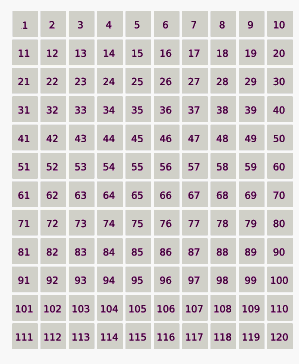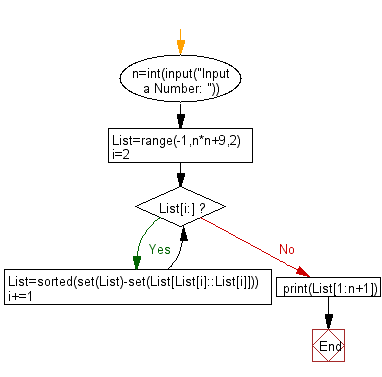Python Math: Print the first n Lucky Numbers
Python Math: Exercise-17 with Solution
Write a Python program to print the first n Lucky Numbers.
Lucky numbers are defined via a sieve as follows.
Begin with a list of integers starting with 1 :
1, 2, 3, 4, 5, 6, 7, 8, 9, 10, 11, 12, 13, 14, 15, 16, 17, 18, 19, 20, 21, 22, 23, 24, 25, . . . .
Now eliminate every second number :
1, 3, 5, 7, 9, 11, 13, 15, 17, 19, 21, 23, 25, ...
The second remaining number is 3, so remove every 3rd number:
1, 3, 7, 9, 13, 15, 19, 21, 25, ...
The next remaining number is 7, so remove every 7th number:
1, 3, 7, 9, 13, 15, 21, 25, ...
Next, remove every 9th number and so on.
Finally, the resulting sequence is the lucky numbers.
Following animation demonstrating the lucky number sieve. The numbers in red are lucky numbers.

Animation Credits: Celtic Minstrel
Sample Solution:-
Python Code:
n=int(input("Input a Number: "))
List=range(-1,n*n+9,2)
i=2
while List[i:]:List=sorted(set(List)-set(List[List[i]::List[i]]));i+=1
print(List[1:n+1])
Sample Output:
Input a Number: 10 [1, 3, 7, 9, 13, 15, 21, 25, 31, 33]
Flowchart:

Visualize Python code execution:
The following tool visualize what the computer is doing step-by-step as it executes the said program:
Python Code Editor:
Have another way to solve this solution? Contribute your code (and comments) through Disqus.
Previous: Write a Python program to print all permutations of a given string (including duplicates).
Next: Write a Python program to computing square roots using the Babylonian method.
What is the difficulty level of this exercise?
Test your Programming skills with w3resource's quiz.
Python: Tips of the Day
Find current directory and file's directory:
To get the full path to the directory a Python file is contained in, write this in that file:
import os dir_path = os.path.dirname(os.path.realpath(__file__))
(Note that the incantation above won't work if you've already used os.chdir() to change your current working directory, since the value of the __file__ constant is relative to the current working directory and is not changed by an os.chdir() call.)
To get the current working directory use
import os cwd = os.getcwd()
Documentation references for the modules, constants and functions used above:
- The os and os.path modules.
- The __file__ constant
- os.path.realpath(path) (returns "the canonical path of the specified filename, eliminating any symbolic links encountered in the path")
- os.path.dirname(path) (returns "the directory name of pathname path")
- os.getcwd() (returns "a string representing the current working directory")
- os.chdir(path) ("change the current working directory to path")
Ref: https://bit.ly/3fy0R6m
- New Content published on w3resource:
- HTML-CSS Practical: Exercises, Practice, Solution
- Java Regular Expression: Exercises, Practice, Solution
- Scala Programming Exercises, Practice, Solution
- Python Itertools exercises
- Python Numpy exercises
- Python GeoPy Package exercises
- Python Pandas exercises
- Python nltk exercises
- Python BeautifulSoup exercises
- Form Template
- Composer - PHP Package Manager
- PHPUnit - PHP Testing
- Laravel - PHP Framework
- Angular - JavaScript Framework
- Vue - JavaScript Framework
- Jest - JavaScript Testing Framework
